
# 2916a - 1996 Flag Over Porch Booklet Pane - Red
US #2916a
1995 Flag Over Porch
- Booklet pane of 10
- Stamp was produced by three printers in a variety of formats
- Additional versions were released over the next two years
Category of Stamp: Definitive
Value: 32¢, First-Class Mail rate
First Day of Issue: May 19, 1995
First Day City: Denver, Colorado
Quantity Issued: 209,629,000
Printed by: Bureau of Engraving and Printing
Printing Method/Format: Photogravure. Booklet panes of 10, from cylinders of 480 subjects (20 across, 24 down)
Perforations: 10.8 X 9.8
Reason the stamp was issued: This stamp was issued in sheet, booklet, and coil formats to fulfill the First-Class mail rate. The booklet stamps were sold as one pane of 10 or two panes of 10.
About the stamp design: The design was created by commercial illustrator Dave LeFleur. He was given the assignment to show a flag hanging from the front porch of a Victorian-era house. The flag is in the foreground and a portion of the porch and house is in the background. The house was not based on an existing house but one in the artist’s imagination.
Special design details: The red year date on these BEP stamps is smaller than the blue dates found on the stamps produced by Stamp Venturers and Avery Dennison.
About the printing process: The Bureau of Engraving and Printing produced these stamps in coils and booklets. Avery Dennison produced self-adhesive coil and booklet stamps. Large rolls of coil stamps and sheet stamps with the same design were produced by Stamp Venturers.
First Day City: The Flag Over Porch booklet stamps were issued on May 19 at the Rompex stamp show in Denver, Colorado.
History the stamp represents: Featuring a Victorian-style house behind a waving American flag, this 32-cent stamp was produced as both a self-adhesive and a normally gummed version. The original plans for releasing both versions of the stamps on May 19, 1995, were changed due to the huge demand from the public for the easy-to-use self-adhesives. As a result, the self-adhesive version was released a month earlier than scheduled, on April 18, 1995.
The Flag Over Porch stamp also marked the first time a self-adhesive stamp was issued with simulated perforation die cuts, so that it appeared to be perforated.
In 1996 and 1997, additional Flag Over Porch stamps were issued in self-adhesive format to meet consumer demand. Produced as a coil and booklet, these stamps mark the first time the self-adhesive format was printed at the Bureau of Engraving and Printing since 1974. The 1997 release differs from the 1996 Flag Over Porch printed by Stamp Venturers only in the perforation measurement and in the absence of a liner or backing paper. Instead of a peel-off backing paper, the front of the linerless stamps received a special silicone coating to prevent the self-adhesive stamps from sticking to one another when coiled.
US #2916a
1995 Flag Over Porch
- Booklet pane of 10
- Stamp was produced by three printers in a variety of formats
- Additional versions were released over the next two years
Category of Stamp: Definitive
Value: 32¢, First-Class Mail rate
First Day of Issue: May 19, 1995
First Day City: Denver, Colorado
Quantity Issued: 209,629,000
Printed by: Bureau of Engraving and Printing
Printing Method/Format: Photogravure. Booklet panes of 10, from cylinders of 480 subjects (20 across, 24 down)
Perforations: 10.8 X 9.8
Reason the stamp was issued: This stamp was issued in sheet, booklet, and coil formats to fulfill the First-Class mail rate. The booklet stamps were sold as one pane of 10 or two panes of 10.
About the stamp design: The design was created by commercial illustrator Dave LeFleur. He was given the assignment to show a flag hanging from the front porch of a Victorian-era house. The flag is in the foreground and a portion of the porch and house is in the background. The house was not based on an existing house but one in the artist’s imagination.
Special design details: The red year date on these BEP stamps is smaller than the blue dates found on the stamps produced by Stamp Venturers and Avery Dennison.
About the printing process: The Bureau of Engraving and Printing produced these stamps in coils and booklets. Avery Dennison produced self-adhesive coil and booklet stamps. Large rolls of coil stamps and sheet stamps with the same design were produced by Stamp Venturers.
First Day City: The Flag Over Porch booklet stamps were issued on May 19 at the Rompex stamp show in Denver, Colorado.
History the stamp represents: Featuring a Victorian-style house behind a waving American flag, this 32-cent stamp was produced as both a self-adhesive and a normally gummed version. The original plans for releasing both versions of the stamps on May 19, 1995, were changed due to the huge demand from the public for the easy-to-use self-adhesives. As a result, the self-adhesive version was released a month earlier than scheduled, on April 18, 1995.
The Flag Over Porch stamp also marked the first time a self-adhesive stamp was issued with simulated perforation die cuts, so that it appeared to be perforated.
In 1996 and 1997, additional Flag Over Porch stamps were issued in self-adhesive format to meet consumer demand. Produced as a coil and booklet, these stamps mark the first time the self-adhesive format was printed at the Bureau of Engraving and Printing since 1974. The 1997 release differs from the 1996 Flag Over Porch printed by Stamp Venturers only in the perforation measurement and in the absence of a liner or backing paper. Instead of a peel-off backing paper, the front of the linerless stamps received a special silicone coating to prevent the self-adhesive stamps from sticking to one another when coiled.













